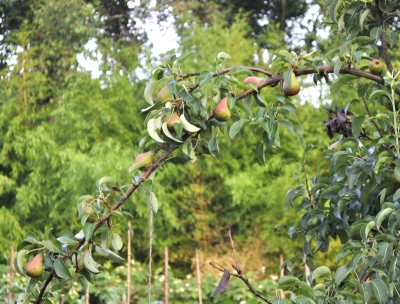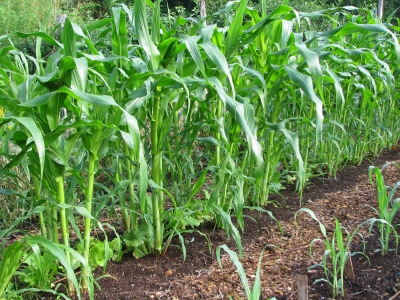Controversial Garlic & Corn
/23 Comments/in Gardening, Planning, Soil, Vegetables/by Lee ReichWhen to Plant & Whether to Plant, Corn & Garlic
Into the ground goes the stinking rose. That’s garlic. As a matter of fact, by the time you read this my garlic cloves will have been in the ground for awhile, since the beginning of the month, already sending roots out into the soft earth.
Planting garlic this early is sacrilege in most garlic circles. But it may make sense.
Garlic needs a period of cool weather, with temperatures in the 40s, to develop heads. Without that cool period, a planted clove merely grows larger, without multiplying. Which is why it’s planted in fall. Spring-planted garlic might still get sufficiently chilled or needs to be artificially chilled, but yields are generally are lower than fall-planted garlic. 
Lower yields could also be because the cloves, planted in spring, must put energy into growing both leaves and roots. Roots grow whenever soil temperatures are above 40 degrees F., so fall-planted cloves start growing roots immediately. And for quite a while because, with the ground cooling more slowly than the air, balmy weather lingers long in the soil in fall, especially when it’s covered with an insulating layer of wood chips, compost, straw, or other organic mulch.
My reasoning for late summer planting rather than fall planting is that the sooner the bulbs are in the ground, the more time roots have to grow before temperatures drop consistently below 40 degrees. More root growth now means more roots to fuel leaf growth in spring which, in turn, means bigger heads to harvest next summer. More root growth also means that cloves are more firmly anchored into the ground through winter, so are less likely to heave up and out of the ground as it freezes and thaws.
The caution against planting as early as I suggest is that leaves might awaken and push up through the ground in fall, only to be snuffed out by winter cold. True. But garlic is a monocotyledenous plant, so its growing point, like that of other “monocots” (such as lilies, onions, grasses, orchids, and bananas), lies beneath the ground, protected from cold. The usual recommendation for garlic planting is to plant early enough to allow time for some root growth but late enough so leaves don’t appear aboveground.
Leaves peering above ground in fall might even help spur root growth, at least once they start exporting energy. (Their initial growth is fueled by energy reserves in the planted clove.) Even if winter cold kills the leaves, they will have done some good if they begin growth soon enough. The sloppy mess of frozen leaves could, admittedly, breed unwelcome bacteria or fungi.
Biological systems are complex, and plants don’t read what I write and may not follow my reasoning. Just to check, I planted only half of my garlic bed; I’ll plant the other half in a month, the recommended planting time. Next summer I’ll know if my garlic cloves followed my reasoning.
Corn, Worth Planting
Garlic is for the future; sweet corn is for the present. Whoever it was — and there were plenty of those “whoevers” — that recommended against growing sweet corn in a small garden because it wasn’t worth the space did a disservice to gardeners. My garden isn’t all that big yet we’ve been harvesting all the sweet corn we can eat and freeze since early August and will continue to do so for much of this month.
My vegetable garden is in 18 foot long, 3 foot wide beds, and I planted 4 beds at two week intervals from early May until the third week in June. I sowed the seeds sown in hills (clumps) to end up with 3 to 4 plants every two feet in a double row running down each bed. Planting in hills provides better pollination and resistance to wind than planting rows of single, more closely spaced plants.
Each stalk yields one or two ears, so a conservative 1.5 ears per stalk and 3 plants per hill computes to yields of 81 ears of corn from each of four beds. That’s a lot of sweet corn! And not just any sweet corn, but Golden Bantam Sweet corn, the standard of excellence in sweet corn a hundred years ago. You can’t buy ears of this variety these days. It’s the only one I grow.
Pumping out all those delectable ears requires good growing conditions. To whit: Very fertile, well drained soil; water as needed; and little competition from weeds. I slathered the beds with an inch or more of compost in spring and all summer plants’ thirst has been daily and automatically quenched with drip irrigation.
I didn’t even have to devote those beds to only sweet corn for the whole season. Earliest plantings were preceded and are followed by quickly maturing vegetables such as lettuce, spinach, and radishes. Turnips, winter radishes, and bush beans are other possibilities to follow harvest of those first sowings of sweet corn. A row of carrots and beets was sown
up the middle of the second planting shortly after the corn emerged and is doing fine now that the corn has been harvested and those plants cleared away. I’m still trying to figure out what to plant to follow the third planting, which is just finishing up.
I also grow popcorn, but that’s another, also delectable story.
Hormones Get Pumping
/5 Comments/in Books, Fruit, Gardening, Vegetables/by Lee ReichMore Brussels Sprouts, Cabbages, & Pears with Hormones
It’s time to get the hormones pumping. No, not by me embarking on some testosterone-fueled, garden-related feat of strength or endurance. Not even my own hormones, but the ones in my plants, more specifically my brussels sprouts plants. And actually, quashing the action of one hormone so that other hormones can come to the fore.
Let me explain: Brussels sprouts are not only a member of the cabbage family but are the same genus and species as cabbage, as are broccoli, cauliflower, kohlrabi, and kale. Differences in these plants lie in the way growth of the stems and leaves are expressed. Cabbage has a single stem that’s been telescoped down to very short internodes, resulting in a tight head of overlapping leaves. With kale, internodes along the stem are further apart, allowing each leaf to unfold fully on its own. They also look different from those of cabbage.
In every plant, a shoot bud develops in the upper part of the crotch where a leaf joins a stem. Most brussels sprouts buds each start to develop enough to form a small, cabbage like head. But I — and probably you also — want large brussels sprouts sprouts (and more of them, so I also want tall brussels sprouts plants on which to attach the sprouts).
The sprouts are retarded somewhat in their development by a hormone called auxin. Auxin is one of many plant hormones coursing about within leaves, fruits, shoots, and roots, their effect dependent on such variables as plant part, plant age, and what other hormones they are reacting with. One place of auxin synthesis is in the tips of stems, and their effect is to suppress growth of buds down along the stem, with more suppression the closer a bud is to the tip of the stem. I just looked at my brussels sprouts plants; yes, the largest sprouts are those nearest ground level. It’s still too early to harvest and too many of the upper sprouts, at present, are too small to be worth picking.
Suppressing auxin production in the tip of the stem releases their hold on the buds — that is, the sprouts — along the stem, so they can grow larger. Suppressing auxin production is simple, requiring only two fingers: Just snap off the tip of the stem. No tip, no auxin production, for a while, at least. The time to do this “operation” is the beginning of September. Done too soon, and a developing sprout might grow so bold as to grow out into, at worst, shoots or, less worse, loose heads. Plus, earlier in the season, I want to keep the stem elongating to provide real estate along which to hang more sprouts.
A Three-Headed Cabbage!
As I wrote, every plant develops buds in its leaf axils, and in every plant growth of those buds is mediated, in part, by auxin. Harvest the main head of broccoli and side shoots start to grow for eventual harvest.
Even tight heads of cabbage have those buds and they also respond to auxin’s influence. I used to plant cabbage in the spring for harvest in summer. Rather than pulling out the spent cabbage plants, as is usually done, I would leave the cut stump with a few bottom leaves for nourishment. Harvesting the cabbage dramatically removes the tip of the stem, which was buried within the head.
Within a couple of weeks, new sprouts would develop in the crotches where leaves were or had been. In the ideal world, I’d get one to three new cabbage heads from each plant, ready for autumn harvest. A certain amount of art was needed to get it right. Depending on growing conditions and the number of new heads I allowed to develop, they might end up too small or too loose-leaved.
I’ve abandoned that chancy cabbage habit and now do a second sowing of cabbage in early June for a reliable autumn harvest of firm heads.
Pears — More, Please
I fiddled around with hormones earlier this season also, with longer term goals in mind. Auxin keeps the tip of a stem or the upper portions of a plant growing most vigorously. Vigorous growth, though, is at odds with making fruit. After all, both require a lot of a plant’s energy, so the plant has to partition the energy efficiently between growing and fruiting.
 Pear trees are famous for growing vigorous shoots skyward. Yes, shoot growth is needed on which to hang fruit and for adequate leaves for photosynthesis. But enough is enough. Rather than pinch out shoot tips, which would likely just pass on the vigor to nearby lower buds, I bent ranches down and held them there with string. Changing stem orientation from vertical to at or near horizontal quells auxin production, slows growth, and promotes the formation of fruit buds along the stem. (Fruit buds form the year before flowers open.)
Pear trees are famous for growing vigorous shoots skyward. Yes, shoot growth is needed on which to hang fruit and for adequate leaves for photosynthesis. But enough is enough. Rather than pinch out shoot tips, which would likely just pass on the vigor to nearby lower buds, I bent ranches down and held them there with string. Changing stem orientation from vertical to at or near horizontal quells auxin production, slows growth, and promotes the formation of fruit buds along the stem. (Fruit buds form the year before flowers open.)
Fruits now dangle from some of the stems that I pulled down a year ago last spring. The response can take more than a year as energy reserves are redistributed within the stem. Response also depends on a tree’s inherent vigor, growing conditions for the season, the pear variety, the degree of stem bending, and other knowns and unknowns. It’s takes a mix of science, art, and experience, and that’s what makes gardening so interesting for me.








